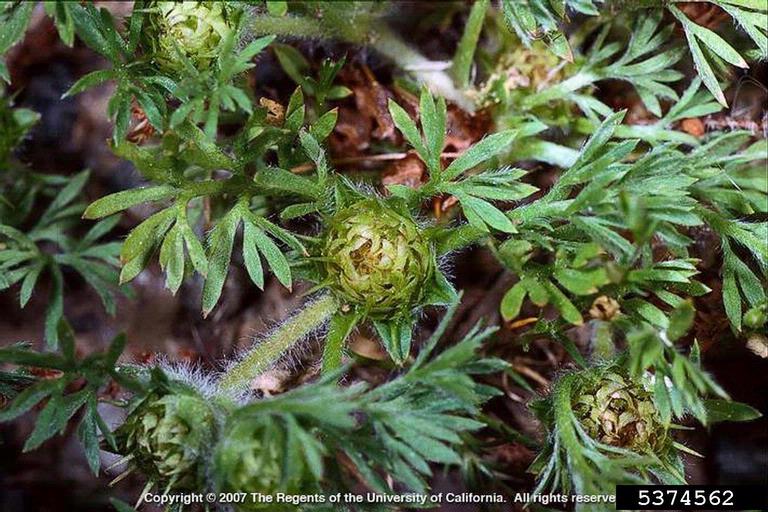
by Matthew Orwat | Oct 6, 2015
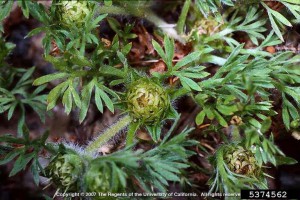
Lawn Burweed, Soliva Sessilis, Closeup – Image Credit: Joseph M. DiTomaso, University of California – Davis, Bugwood.org, Create Commons License
On this bright and sunny early fall morning I was thinking about all of the great gardening opportunities the cooler fall weather is bringing us in the Florida Panhandle. However, my thoughts drifted to the annoyances that the gardeners find when trying to enjoy their lawn or garden.
On the top of my list is stepping into a patch of burweed, which is in the sunflower family and is also known as spurweed. The leaves are opposite along the stem and sometimes resemble parsley. The main ways which burweed can irk the casual gardener are sticking to socks, sneaking in with the dog, or littering flower beds with its nuisance. It can also hide in the house and reappear when shoes are removed. This causes pain in both the foot and the ear.
Aside from herbicides, maintaining a healthy vigorous lawn will prevent weeds from taking over. If you lawn is reasonably healthy and only a few instances of this weed exist, try to mechanically remove them and encourage the lawn to outgrow them.
If cultural methods aren’t sufficient, science has given us several options to control this irksome pest. A widely used pre-emergence product for burweed control is isoxaben, which is sold under the brand name of Gallery as well as others. It prevents the weed from emerging from the ground when it germinates and can be used on St. augustine, centipede, bahia and zoysia lawns, as well as ornamental shrub beds. In northwest Florida, this herbicide needs to be applied in October for best results.
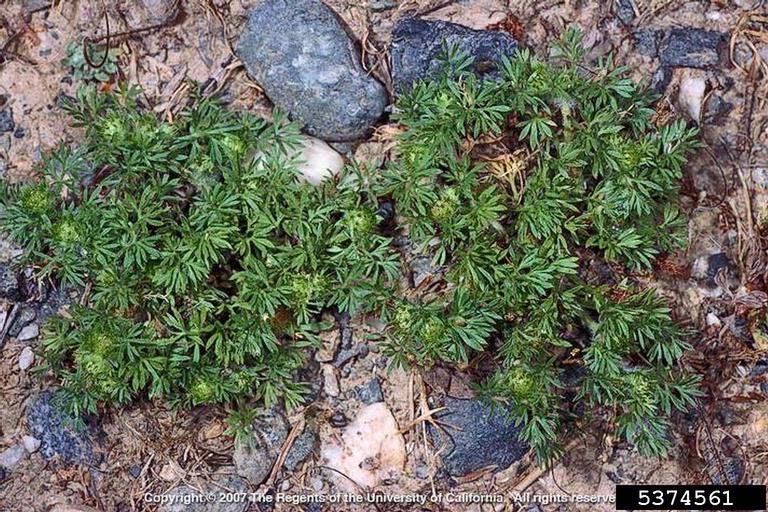
Burweed, Soliva Sessilis. – Image Credit: Joseph M. DiTomaso, University of California – Davis, Bugwood.org. Creative Commons License
Herbicides which contain the active ingredients dicamba, 2,4-D or atrazine are good at controlling burweed as a post emergence control when applied from December through early March. Be careful to use reduced rates on centipede and St. augustine lawns, and never use more than the labeled rate. Later applications have less effect on burweed because as it matures it is harder to control. Additionally the burs, once present on the lawn, are hard to remove. As the daytime temperatures get a few degrees over 80, some of these herbicides may cause lawn damage so immediate application is advised. Try to keep the spray residue outside of the root zone of desirable plants to avoid injury and always follow label directions. Be aware that burweed reproduces by seed, so mowing it down will only increase the problem by burying the seed for fall germination.
The active ingredients mentioned above are present in a variety of ‘trade name’ products* available from your local garden center, farm supply or CO-OP. I hope all the northwest Florida lawns prevent burweed so that the spring lawns will be burweed free. Happy Gardening!
| Common Name |
Manufacturer / Distributor |
Brand Names |
Type |
| Atrazine |
Many |
Many |
Pre and Post Emergent |
| 2,4-D +
MCPP + dicamba (3 way combined herbicide) |
Bayer, + others |
Many |
Post-Emergent |
| Isoxaben |
Dow, Others |
Gallery, others are now on the market |
Pre-Emergent |
*Table reproduced from sections of the 2012 version of University of Florida’s Pest Control Guide for Turf Grass Managers.
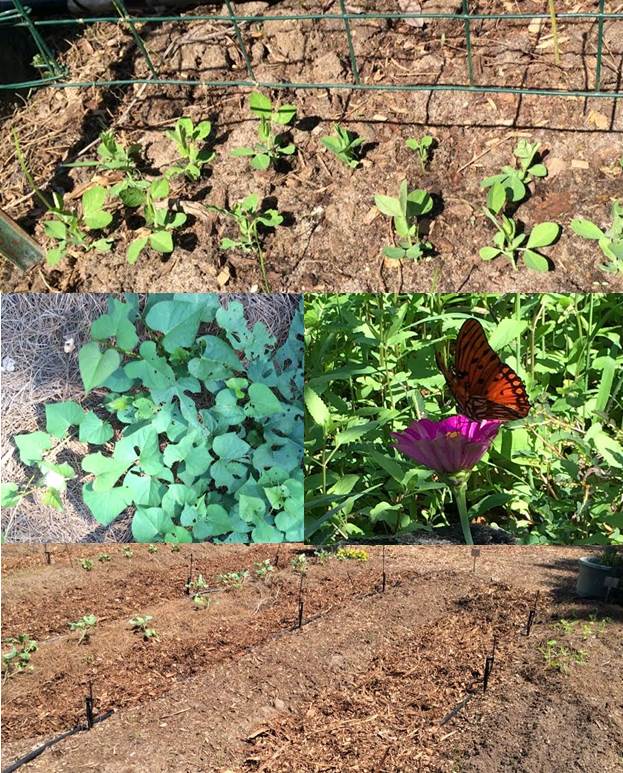
by Molly Jameson | Oct 6, 2015

A diverse garden attracts pollinators and helps balance soil fertility. Photo by Molly Jameson.
The kids are back to school and you know what that means – everyone in the house will soon come down with the sniffles and a sore throat. But what if when the kids came home, Jack went straight to his room, Susie to her room, Dad went to work in the garage, and Mom read in the office? This separation – along with good hand washing techniques – may be what prevents the entire house from turning into a sick ward. Since humans are very closely related genetically, we are susceptible to many of the same diseases. Well, believe it or not, plant families operate very similarly. If you keep planting crops together that are in the same plant family, they will be susceptible to the same diseases.
Although it can be challenging to keep your family from getting sick, there are certain practices in the garden that can go a long way in keeping your vegetable plants disease free and healthy. One easy step you can take is implementing a crop rotation. By separating crops that are in the same family during the season and not planting the same plant families in the same locations year after year, you not only help prevent diseases, but it will also help control insects, balance nutrients, and improve the condition of your soil.
Probably the most important reason to use a crop rotation system is to prevent plant diseases. For example, if you grow tomatoes in the same section of your garden year after year, certain pathogens that attack tomatoes, such as some bacterial spots and blights, can overwinter in your garden, and will have an easily accessible host (next year’s tomatoes) the following spring. Tomatoes are in the nightshade family, along with crops such as potatoes, peppers, and eggplants. If these crops are planted in the same location, they then become susceptible to the same pathogens, and the cycle continues.
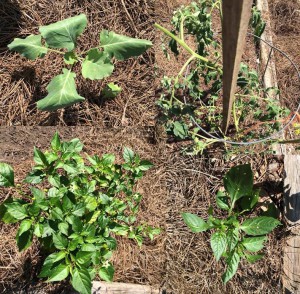
Turn your garden into a revolving collage. Photo by Molly Jameson.
Many pests in the garden are also attracted to many of the same crops. For instance, the mustard or brassica family, which includes vegetables such as broccoli, kale, collards, and turnips, easily attract aphids. By regularly rotating your brassicas, you can help break the life cycles of these garden pests.
Another important aspect of crop rotation is considering the fertility and health of your soil. Different crops require different types and amounts of nutrients to grow. Legumes, such as peas and beans, actually “fix” nitrogen from the atmosphere, which can increase the nitrogen in your soil, reducing your need to add fertilizers. You would then want to follow legumes with plants that require a lot of nitrogen, such as lettuce or broccoli. Subsequently, follow heavy feeders with light feeding root vegetables, such as onions or carrots, which are good nitrogen “scavengers.”
Root crops also help break up the soil, which is then advantageous to legumes, which thrive in loose soil. Growing leguminous “cover crops,” such as clovers and alfalfa, is an excellent way to improve the fertility and organic matter content of your soil. Incorporate the biomass of the cover crops into your soil prior to seed production for optimum benefits.
Remember that the key to both a healthy garden and a healthy diet is diversity! Incorporating many different botanical families into your garden will help break disease life cycles, attract beneficial insects, effectively utilize soil nutrients, and improve soil composition. In turn, eating many different types of vegetables will ensure that you are getting the full spectrum of vitamins and minerals. Which, by the way, will help keep your family healthy and strong and able to combat those pesky colds!





